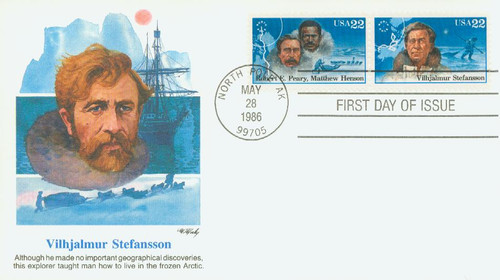
# 2223 FDC - 1986 22c Arctic Explorers: Robert E. Peary and Matthew Henson
Â
22¢ Robert Perry and Matthew Henson
Polar Explorers
City: North Pole, AK
Quantity:Â 5,825,050
Printed By: American Bank Note Co
Printing Method: Photogravure
Perforations: 11
Color: Multicolored
Â
Explorer Robert Edwin Peary Sr. was born on May 6, 1856, in Cresson, Pennsylvania. Peary claimed to have been one of the first people to reach the North Pole. Though his claim has been debated, historians generally agree he at least came very close. After Peary’s father died in 1859, the family moved to Portland, Maine. He went on to attend Bowdoin College, graduating with a civil engineering degree in 1877. After school, Peary worked as a draftsman for the US Coast and Geodetic Survey. Peary then joined the Navy in 1881 and was commissioned in the Civil Engineer Corps. In the 1880s he was an engineer for the Nicaragua Canal. Then in 1885, he decided he wanted to be the first person to reach the North Pole. Peary embarked on his first Arctic expedition the following year. He set out to travel across Greenland to see if it was an island or if it went all the way across the Arctic. He and a partner made it almost 100 miles before running low on food and deciding to turn back. At the time, it was the second-farthest distance traveled across Greenland’s ice sheet. While he didn’t achieve his goal, the expedition gave him a greater understanding of what such a long trip would require. In 1887, the Navy ordered Peary to survey routes for the proposed Nicaragua Canal. While preparing for this trip he met clerk Matthew Henson. Henson told Peary he’d spent six years as a cabin boy and Peary hired him as his personal valet. Henson would become Peary’s field assistant and join him on all of his Arctic expeditions going forward. Peary led another expedition to Greenland in 1891. However, one of his legs was broken in an accident with the ship’s iron tiller and the expedition camped for six months waiting for him to recover. His team became well acquainted with the area and he established his “Peary system†of utilizing support teams to set up supply caches along Arctic travel routes. Once his leg was healed, they set out on their mission, eventually reaching Navy Cliff. There they got the answer to their question – Greenland was indeed an island. By the time they returned home they had traveled 1,250 miles. Peary launched additional expeditions between 1898 and 1902. His extensive mapping of uncharted areas was recognized with a number of awards from geographical societies. Peary launched another well-funded expedition in 1905. During that expedition, he was separated from his party and claimed to have reached the farthest point north of any explorer up to that time (87°06′) on April 21, 1906. On the return journey, he discovered Cape Colgate. Upon his return the National Geographic Society credited him with a farthest north honor, though no other societies did. Peary launched his final expedition to the North Pole in 1908. By early April 1909, he established Camp Jesup, which he believed was within three miles of the pole. His assistant Henson scouted ahead to what they believed was the North Pole and returned claiming, “I think I’m the first man to sit on top of the world.â€Â When Peary returned home he discovered Frederick A. Cook, who had accompanied his 1891 expedition, claimed to have reached the pole in 1908. In spite of this the National Geographic Society and Congress’ Naval Affairs Subcommittee credited Peary with reaching the North Pole. He received the Thanks of Congress in 1911 and was promoted to rear admiral. Peary retired from the Navy in 1911. He served as president of The Explorers Club twice and chairman of the National Aerial Coast Patrol Commission. Peary supported using planes to search for warships and submarines off the US coast and later proposed eight airmail routes that helped establish America’s airmail system. He died on February 20, 1920. Peary received a number of medals and honors during his life. Doubts over his claim of reaching the pole have always persisted, however, and inspired numerous investigations of his diaries and even a recreation expedition.Birth of Robert E. Peary
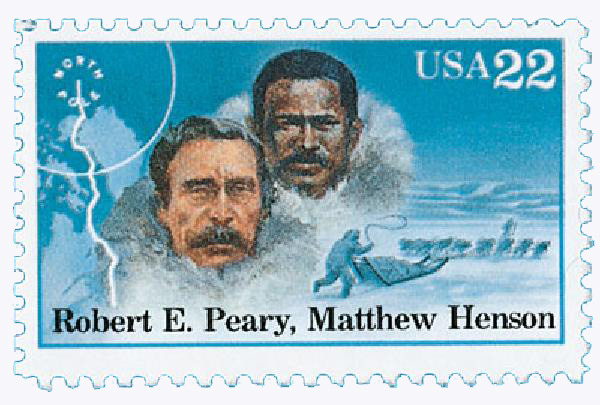


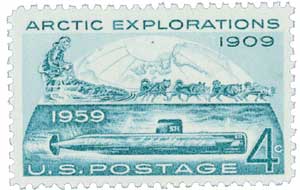

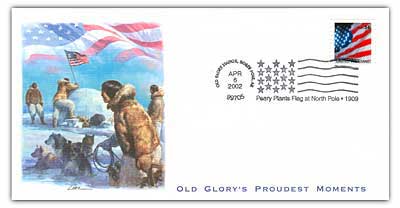
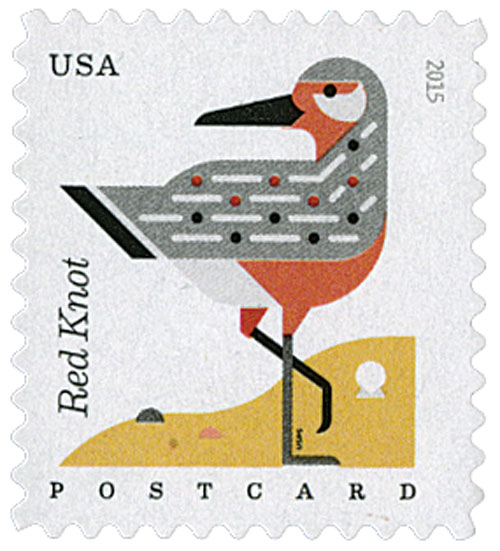

Â
22¢ Robert Perry and Matthew Henson
Polar Explorers
City: North Pole, AK
Quantity:Â 5,825,050
Printed By: American Bank Note Co
Printing Method: Photogravure
Perforations: 11
Color: Multicolored
Â
Explorer Robert Edwin Peary Sr. was born on May 6, 1856, in Cresson, Pennsylvania. Peary claimed to have been one of the first people to reach the North Pole. Though his claim has been debated, historians generally agree he at least came very close. After Peary’s father died in 1859, the family moved to Portland, Maine. He went on to attend Bowdoin College, graduating with a civil engineering degree in 1877. After school, Peary worked as a draftsman for the US Coast and Geodetic Survey. Peary then joined the Navy in 1881 and was commissioned in the Civil Engineer Corps. In the 1880s he was an engineer for the Nicaragua Canal. Then in 1885, he decided he wanted to be the first person to reach the North Pole. Peary embarked on his first Arctic expedition the following year. He set out to travel across Greenland to see if it was an island or if it went all the way across the Arctic. He and a partner made it almost 100 miles before running low on food and deciding to turn back. At the time, it was the second-farthest distance traveled across Greenland’s ice sheet. While he didn’t achieve his goal, the expedition gave him a greater understanding of what such a long trip would require. In 1887, the Navy ordered Peary to survey routes for the proposed Nicaragua Canal. While preparing for this trip he met clerk Matthew Henson. Henson told Peary he’d spent six years as a cabin boy and Peary hired him as his personal valet. Henson would become Peary’s field assistant and join him on all of his Arctic expeditions going forward. Peary led another expedition to Greenland in 1891. However, one of his legs was broken in an accident with the ship’s iron tiller and the expedition camped for six months waiting for him to recover. His team became well acquainted with the area and he established his “Peary system†of utilizing support teams to set up supply caches along Arctic travel routes. Once his leg was healed, they set out on their mission, eventually reaching Navy Cliff. There they got the answer to their question – Greenland was indeed an island. By the time they returned home they had traveled 1,250 miles. Peary launched additional expeditions between 1898 and 1902. His extensive mapping of uncharted areas was recognized with a number of awards from geographical societies. Peary launched another well-funded expedition in 1905. During that expedition, he was separated from his party and claimed to have reached the farthest point north of any explorer up to that time (87°06′) on April 21, 1906. On the return journey, he discovered Cape Colgate. Upon his return the National Geographic Society credited him with a farthest north honor, though no other societies did. Peary launched his final expedition to the North Pole in 1908. By early April 1909, he established Camp Jesup, which he believed was within three miles of the pole. His assistant Henson scouted ahead to what they believed was the North Pole and returned claiming, “I think I’m the first man to sit on top of the world.â€Â When Peary returned home he discovered Frederick A. Cook, who had accompanied his 1891 expedition, claimed to have reached the pole in 1908. In spite of this the National Geographic Society and Congress’ Naval Affairs Subcommittee credited Peary with reaching the North Pole. He received the Thanks of Congress in 1911 and was promoted to rear admiral. Peary retired from the Navy in 1911. He served as president of The Explorers Club twice and chairman of the National Aerial Coast Patrol Commission. Peary supported using planes to search for warships and submarines off the US coast and later proposed eight airmail routes that helped establish America’s airmail system. He died on February 20, 1920. Peary received a number of medals and honors during his life. Doubts over his claim of reaching the pole have always persisted, however, and inspired numerous investigations of his diaries and even a recreation expedition.Birth of Robert E. Peary















